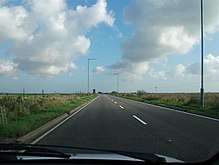Acle Straight
The Acle Straight, also known as the Acle New Road is a major road between Acle and Great Yarmouth in Norfolk. It is part of the A47 trunk road.[1]

History

The road was originally proposed as a turnpike on 3 May 1830 following an Act of Parliament[2] and engineered by William Thorold. Its purpose was to provide quicker access between the two towns over the Halvergate Marshes. It was designed as two straight sections, connected by a bend halfway along which included a branch road between Seven Mile House and Halvergate. This reduced the distance from Great Yarmouth to Norwich by 3 miles 5 furlongs (5.83 km).[1][3] The road was constructed by digging two parallel ditches, 37 feet (11 m) feet apart, with a surface comprising brushwood, gravel and soil from the ditches. It was largely complete by April 1831 and opened later that year.[4][5]
Tolls were removed from the road in 1861, though they remained on the Yarmouth Suspension Bridge over the River Bure into the town centre until 1920.[6]
In 1882, the railway line between Acle and Great Yarmouth was built parallel to the Acle Straight.[7] The Stracey Arms Windpump was built in 1883 near the Halvergate branch road junction. It was Grade II* listed in 1982. A similarly-named pub, the Stracey Arms, opened next door to the windmill. It subsequently became popular with boaters on the Norfolk Broads as it sat directly between the Acle Straight and the River Bure and had private moorings. In 2015, it was converted into a Hindu temple.[8][9][10][11]
The Acle Straight experienced problems with subsidence. In 1908, a deep pile was planned, but was abandoned after testing found the ground was stable up to a depth of 11 feet (3.4 m).[1]
Traffic
The road is a notorious accident spot, with numerous fatalities.[4] As it runs through the middle of uninhabited wetlands, there is no practical alternative route, and detours can be up to 30 miles (48 km).[12] There have been proposals to widen the road to dual carriageway, but these have been rejected owing to environmental concerns.[13]
Cultural references
Several ghost stories have featured the Acle Straight. A driver passing the turning to the Halvergate branch spotted a man walking out into the middle of the road. Unable to stop, he drove straight through him. There have also been reports of a horse and cart crossing directly in front of oncoming traffic, and drivers have reported wanting to perform an emergency stop for no reason.[4]
The Acle Straight is mentioned in the song "Stuck In A Rut" by local band The Darkness. The lyrics refer to the group trying to get out of their hometown of Lowestoft, with the road as one possible escape route.[14]
References
- "The Acle Straight, or Acle New Road". Norfolk Heritage. Norfolk County Council. Retrieved 29 November 2017.
- "The London Gazette" (PDF). 4 May 1830: 1. Retrieved 4 January 2018. Cite journal requires
|journal=(help) - Roots, Michael. "William Thorold". Norfolk Mills. Retrieved 4 January 2018.
Originally published in The Norfolk Chronicle, 23 April 1831.
- "Weird Norfolk: The ghosts of the Acle Straight". Eastern Daily Press. 24 November 2017. Retrieved 28 November 2017.
- Sargent, Peter (2017). A Moment In Time: 50 Stories That Bring East Anglian History To Life. Paul Dickson. p. 209. ISBN 978-0-995-61872-5.
- "No getting a Straight answer to a Straight problem". Great Yarmouth Mercury. 28 January 2016.
- Railway Centenary. Locomotive, Carriage and Wagon Review. 1925. p. 17.
- "Former Broads pub poised to become religious temple". Great Yarmouth Mercury. 10 July 2015. Retrieved 29 November 2017.
- "Landmark Broads pub set for revival". Norwich Evening News. 25 May 2011. Retrieved 29 November 2017.
- Historic England. "Stracey Arms Windpump (1051459)". National Heritage List for England. Retrieved 29 November 2017.
- Edwards, Anne (25 August 2016). "Hindu worshippers hope to foster links with the wider community at temple open day". Great Yarmouth Mercury. Retrieved 1 January 2018.
- "Drivers travelling on the A47 face a 30-mile diversion as one-mile stretch is closed". Great Yarmouth Mercury. 20 October 2017. Retrieved 28 November 2017.
- "A47 Norwich to Great Yarmouth Study". Norfolk County Council. Archived from the original on 2 October 2011. Retrieved 14 November 2008.
- "Literary & Artistic Connections of Lowestoft". Love Lowestoft. 29 April 2014. Retrieved 29 November 2017.